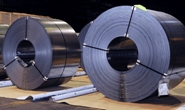Economy

Buyers' “Indecisiveness" Impacts Secondary Sales
Written by Tim Triplett
February 21, 2019
Like the prime steel market, secondary steel is suffering from indecisiveness among buyers who feel uncertain about tariffs and trade and their effects on the economy.
Secondary steel is nonprime or excess material that did not meet the specifications for its original intended use. Mills offer the material at a discount to service centers, who look for buyers that can use it for alternative applications. Historically, an estimated 3-4 percent of domestic steel production ends up in the secondary market due to surface defects and other flaws.
“Everyone is protecting a low inventory, venturing into the secondary market more frequently, but for less volume, to fill in the holes,” said Greg Gross, president of Affinity Metals, Bedford Park, Ill.
Lisa Goldenberg, president of Delaware Steel Co. of Pennsylvania, Fort Washington, Pa., describes a challenging market so far in 2019. December and January, normally strong months, were disappointing. “I was really optimistic for the New Year, but it has just been brutal. I could not have been more off the mark.”
Secondary prices tend to track with prime. The mills have announced two price increases on flat rolled steel in the past month. But the secondary market is not feeling the full effect yet, Goldenberg said. “Because hot rolled is so soft, it feels like manufacturing is really off. But we are quoting a lot of jobs. I think people are just afraid to act.” She points to early signs that activity is picking up in mid-February. “Particularly in the secondary world, people are starting to see that prices are at the bottom and it’s not going to be cheaper next week. If you need it, you’d better pull the trigger.”
“Demand for nonprime is still strong as manufacturing remains a bright spot in the U.S. economy,” said Mike Barnett, president of Grand Steel Products, Wixom, Mich. “There’s not as much demand as last year, but it’s still fairly robust.”
Construction is normally a big outlet for secondary steel. Construction activity is forecast to be strong in 2019, but Delaware Steel’s construction customers have been dragging their feet so far, Goldenberg said. “Where are all the construction orders. March is around the corner. Construction should be gearing up for spring. It makes no sense.”
Construction products companies are moving away from nonprime toward more graded and certified material, so the customer base is shrinking, noted another secondary distributor. Non-load-bearing interior wall studs, for example, used to be a big application for secondary coils. “Now the industry has gone to a specification that manufacturers must adhere to or they can’t be certified. It has driven a lot of the small regional stud manufacturers out of the marketplace,” he said.
It is difficult to generalize about nonprime pricing, sources say. Popular grades, such as 16-gauge G60 galvanized, get snapped up quickly on the secondary market, and at prices near prime. On the other hand, high-strength steel coils that have few alternate uses may have no takers at any price above their scrap value and end up getting remelted by the mill.
This year should be similar to 2018, Gross said, voicing a positive forecast for his company. “The last two price increases have had a flooring effect on prime prices, which may level or rise a bit before dipping again in the second half,” he said. Much depends on what happens on the trade front with tariffs, trade negotiations with China, etc. “Secondary will track along with prime, but the gap between prime and the popular vanilla secondary items will be very minimal.”

Tim Triplett
Read more from Tim TriplettLatest in Economy

New York state manufacturing index drops again in April
Firms were pessimistic, with the future general business conditions index falling to its second lowest reading in the more than 20-year history of the survey

Construction adds 13,000 jobs in March
The construction sector added 13,000 jobs, seasonally adjusted, in March, but tariffs could undermine the industry.

Supply chains, end-users brace for impact from tariffs
Supply chains are working through what the tariffs mean for them

ISM: Manufacturing expansion loses steam after two months of growth
US manufacturing activity slowed in March after two straight months of expansion, according to supply executives contributing to the Institute for Supply Management (ISM)’s latest report.

Chicago Business Barometer rose to 16-month high in March
The Chicago Business Barometer increased for the third-consecutive month in March. Despite this, it still reflects contracting business conditions, as it has since December 2023.
